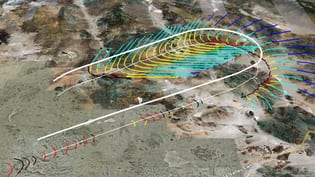 |
| NASA’s initial depiction of sonic boom footprint integrated with real-time, local-area moving map. Rockwell Collins will develop conceptual cockpit display using the data to investigate how to best show this to pilots. Photo: Rockwell Collins |
[Avionics Today 05-15-2015] NASA has awarded Rockwell Collins a two-year contract to develop a conceptual cockpit display that will provide a visual representation of sonic boom over the Earth’s surface to mitigate impact on populated areas. NASA’s Armstrong Flight Research Center will lead the study, working with Rockwell Collins’ Advanced Technology Center.
“In order for supersonic travel over land to happen, pilots will need an intuitive display interface that tells them where the aircraft’s sonic boom is occurring,” said John Borghese, vice president of the Advanced Technology Center for Rockwell Collins. “Our team of experts will investigate how best to show this to pilots in the cockpit and develop guidance to most effectively modify the aircraft’s flight path to avoid populated areas or prevent sonic booms.”
Rockwell Collins will leverage its avionics display technologies and human factors research team to develop the sonic boom cockpit display, incorporating a number of variables such as the aircraft’s movement relative to the ground and the influence of weather on shock waves. Both ground-based and aircraft-measured weather information will be analyzed and integrated into the sonic boom display’s software to compute best flight path. The company’s findings will be applied in NASA’s High Speed Project, which is aimed at providing the research to enable the development of a new generation of supersonic civil transport aircraft.